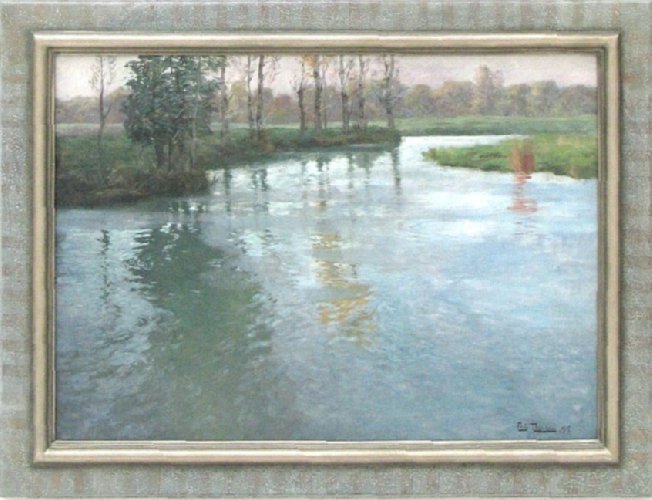Description:
Johan Frits Thaulow (1847-1906) was a Norwegian landscape painter, graphic artist, and writer. He studied at the Academy in Copenhagen and Karlsruhe. His work was strongly influenced by visits to France, which inspired him to establish the “Freiluftakademie” as a reaction against the academic painting traditions in Norway. Ultimately, he moved to Northern France and became a member of the Société Nationale des Beaux-Arts. His most repeated motif in his art was a river depicted at different times of day. He was particularly interested in the so-called “blue hour”, a short moment of dusk when the world is tinged with blue.
Description of the painting:
The main subject of the painting is the Canche River. It flows through Northern France and empties into the English Channel. Its waters spread widely in the painting before narrowing into a winding river course that recedes into the landscape. The calm river surface is covered with a delicate web of ripples distorting the reflections of trees. The dominant blues and greens of the composition are speckled with whites and pinks, enlivened by autumn yellows and oranges. In the distance, behind a flat expanse of grass, a line of trees marks a high horizon. A small portion of the sky sparkles with pinks and purples, which are only faintly echoed in the river’s surface, suggesting that the rest of the sky, not captured in the composition, is filled with a pure blue hue. The artist has thus captured a fleeting moment of color changes taking place in the landscape due to sunrise or sunset.
The observation of the light relationships that take place in the landscape during late evening, night, or morning was particularly appealing to the artist. Although his Norwegian landscapes have a realistic quality, the specific atmosphere they create is almost romantic. In Norway, Thaulow was known as a painter who brought the experiences of the Impressionists to the Scandinavian soil. His paintings often depict winter landscapes in which the artist tries to capture a very short, ephemeral moment, the so-called “blue hour”, when, after sunset, but before full darkness, the world is colored in various shades of blue. When he moved to France permanently, he also focused on painting the nature of small towns, villages, or uninhabited areas, as in the case of the presented landscape.
Rogalinski’s painting presents the artist’s most frequently depicted motif, a river, which seems to be a refrain constantly repeated in his work. Thaulow traveled a lot and tried to constantly search for new frames, but ultimately, although from different places, his paintings present similar views. Incredibly evocatively painted water surfaces fill the next canvases becoming mirrors of the artist’s coloristic searches.


